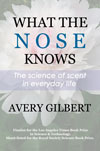
That’s the claim advanced in a Slate piece about Sam Khamis and his Vinod Khosla-funded startup called Adamant Technologies, in Redwood City, California. The story, by Will Oremus, is rather breathless:
an array of sensors that together could potentially detect anything from halitosis to blood glucose levels to an impending electrical fire. The goal: a device that hooks up to your smartphone, turning it into a personal health monitor. [snip] At first, these apps would require a plug-in device that might cost on the order of $100. But Khamis told me his long-term goal is bigger: in short, a digitized, superhuman sense of smell that could someday be integrated into the phone itself.Khamis got his PhD in experimental physics at Penn, where he discovered new ways to manufacture carbon nanotubes. Along with some researchers at the Monell Chemical Senses Center, he found a way to couple olfactory receptor proteins to carbon nanotube transistors. Gas phase odor molecules activate the receptors, and the transistors signal the event to the attached circuitry. Thus, a biological detector is, quite literally, wired into an electronic nose/brain. It’s cool, but not unprecedented, technology.
Adamant Technologies, with series A funding to the tune of $2.5 million, is so far a rudimentary web page. Although the Slate piece doesn’t say so directly, the underlying technology may be the receptor-transistor setup, now the subject of a U.S. patent application by Khamis and Paul Rhodes.
I would love to see this technology succeed. Do I think it will? Not soon. As I pointed out in What the Nose Knows, “The usefulness of an e-nose depends on its software as much as its sensors.” Detecting the different molecules found in bad breath is one thing; recognizing that pattern as bad breath is another and it requires big-time statistical processing and adaptive algorithms. Solving the cocktail party problem (tracking a target signal against a noisy background) is still another hurdle. When it comes to e-noses, the math is harder than the biophysics.
But suppose Khamis’s dream comes true and we each have an e-nose embedded in our smart phone. Then what?
It’s January 2017, and you’re riding a crowded elevator to work. An SBD occurs. The odor app on someone’s iPhone 8 says, “Hey, who cut the cheese?” Everyone stares at the doors. Awkward silence.
After lunch there’s a ruckus. The chick from Accounts Payable is in tears and the HR lady is walking her out of the office. The screen on the HR lady’s iPhone is flashing “Alcohol Violation: Appletini.”
You go the doctor about a sore knee, but first you have to breathe onto his iPhone as part of the mandatory Obamacare protocol. It detects the Marlboro you sneaked three days ago and your health insurance premium automatically goes up 20%.
You come home late one night and your girlfriend waves her iPhone around your neck. It registers the new Lady Gaga fragrance. Your girlfriend doesn’t own the new Lady Gaga fragrance. You sleep on the couch.
You dream about the old days, when smell was still the mysterious sense.




No comments:
Post a Comment